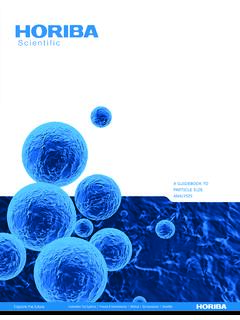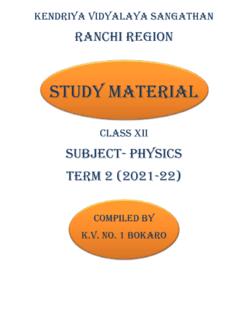Transcription of Quantum Dots - PhysicsOpenLab
1 Quantum dots Fluorescence of Quantum dots colloidal solution Lodovico Lappetito QuantumDots - 20/11/2015 Pag. 1. Table of Contents Quantum dots .. 3. Diffraction Grating Spectrometer .. 4. Fluorescence Spectrometer .. 5. Fluorescence Excitation Sources .. 6. Used Quantum dots .. 6. Quantum dots Fluorescence an Absorption spectra .. 7. CdTe Hydrophilic Quantum Dot 7. CdTe Hydrophilic Quantum Dot Yellow .. 7. CdTe Hydrophilic Quantum Dot Orange .. 8. CdTe Hydrophilic Quantum Dot Red .. 8. CdTe Hydrophilic Quantum Dot Dark Red.
2 9. Theoretical 9. Quantum dots as Particle in a Box .. 10. Measurement 13. QuantumDots - 20/11/2015 Pag. 2. Quantum dots A Quantum dot (QD) is a crystal of semiconductor material whose diameter is on the order of several nanometers - a size which results in its free charge carriers experiencing " Quantum confinement" in all three spatial dimensions. The electronic properties of Quantum dots are intermediate between those of bulk semiconductors and of discrete molecules and closely related to their size and shape.
3 This allows properties such as the band gap, emission color, and absorption spectrum to be highly tuneable, as the size distribution of Quantum dots can be controlled during fabrication. For example, the band gap in a Quantum dot, which determines the frequency range of emitted light, is inversely related to its size. In fluorescent dye applications, the frequency of emitted light increases as the size of the Quantum dot decreases, shifting the color of emitted light from red to violet. The small Quantum dots , such as nanocrystalline semiconductors in a colloidal solution, have dimensions between 2 and 10 nanometers, corresponding to about 10-50 atoms in diameter, and may reach a total of 100-100000 atoms for each Quantum dot.
4 The self-assembled Quantum dots have a size of 10-50 nanometers; while those defined by means of electronic lithography have larger sizes around 100 nm. Besides confinement in all three dimensions ( , a Quantum dot), other Quantum confined semiconductors include: Quantum wires, which confine electrons or holes in two spatial dimensions and allow free propagation in the third. Quantum wells, which confine electrons or holes in one dimension and allow free propagation in two dimensions. The Quantum Dot which contain electrons can also be compared to atoms: both have discrete energy levels and contain a small number of electrons, but unlike the atoms, the confinement potential of Quantum Dot not necessarily show spherical symmetry.
5 Moreover the electrons do not move in the limited space, but inside the semiconductor crystal that hosts them. Researchers have studied applications for Quantum dots in transistors, solar cells, LEDs, and diode lasers. They have also investigated Quantum dots as agents for medical imaging and as possible qubits in Quantum computing. The small size of Quantum dots allows them to be suspended in various solvents and thus compatible with solution processing techniques such as spin coating and inkjet printing.
6 Quantum Dot Image and vials with colloidal solution of Quantum dots . The Quantum dots have fluorescence peak emissions at different wavelengths. QuantumDots - 20/11/2015 Pag. 3. Diffraction Grating Spectrometer Lens Webcam Grating Inside view with collimating lens, grating and webcam Slit Detail of the micrometric slit and the spectrometer assembled Spectrometer Design : Lens Webcam Grating Slit Webcam QuantumDots - 20/11/2015 Pag. 4. Fluorescence Spectrometer Cuvette Laser at 405nm Spectrometer Laser at 532nm Laser at 650nm Laser Cuvette holder holder Construction scheme with excitation lasers and cuvette holder Example of fluorescence of a sample (olive oil) excited with a violet laser at 405nm inside a cuvette QuantumDots - 20/11/2015 Pag.
7 5. Fluorescence Excitation Sources Violet Laser Power: 20mW. Wavelength: 405nm Current: <280mA @ ~ 3V input Color: blue violet Used Quantum dots CdTe hydrophilic Emission maximum CdTe radius Average molar weight Quantum dots (nm) (nm) (Da). PL-QDN-520 520 2,04 16'000. PL-QDN-570 570 3,12 59'000. PL-QDN-600 600 3,39 76'000. PL-QDN-640 640 3,66 96'000. PL-QDN-680 680 4,22 146'000. PlasmaChem Quantum dots colloidal solutions QuantumDots - 20/11/2015 Pag. 6. Quantum dots Fluorescence an Absorption spectra CdTe Hydrophilic Quantum Dot Green Absorption spectrum Excitation UV excited fluorescence spectrum CdTe Hydrophilic Quantum Dot Yellow Absorption spectrum Excitation UV excited fluorescence spectrum QuantumDots - 20/11/2015 Pag.
8 7. CdTe Hydrophilic Quantum Dot Orange Absorption spectrum Excitation UV excited fluorescence spectrum CdTe Hydrophilic Quantum Dot Red Absorption spectrum Excitation UV excited fluorescence spectrum QuantumDots - 20/11/2015 Pag. 8. CdTe Hydrophilic Quantum Dot Dark Red Absorption spectrum Excitation UV excited fluorescence spectrum Theoretical Considerations In semiconductors, light absorption generally leads to an electron being excited from the valence to the conduction band, leaving behind a hole.
9 The electron and the hole can bind to each other to form an exciton. When this exciton recombines ( the electron resumes its ground state), the exciton's energy can be emitted as light. This is called Fluorescence. In a simplified model, the energy of the emitted photon can be understood as the sum of the band gap energy between the highest occupied level and the lowest unoccupied energy level, the confinement energies of the hole and the excited electron, and the bound energy of the exciton (the electron-hole pair): As the confinement energy depends on the Quantum dots size, both absorption onset and fluorescence emission can be tuned by changing the size of the Quantum dot during its synthesis.
10 The larger the dot, the redder (lower energy) its absorption onset and fluorescence spectrum. Conversely , smaller dots absorb and emit bluer (higher energy) light. Recent articles in Nanotechnology and in other journals have begun to suggest that the shape of the Quantum dot may be a factor in the coloration as well, but as yet not enough QuantumDots - 20/11/2015 Pag. 9. information is available. Furthermore, it was shown that the lifetime of fluorescence is determined by the size of the Quantum dot.



